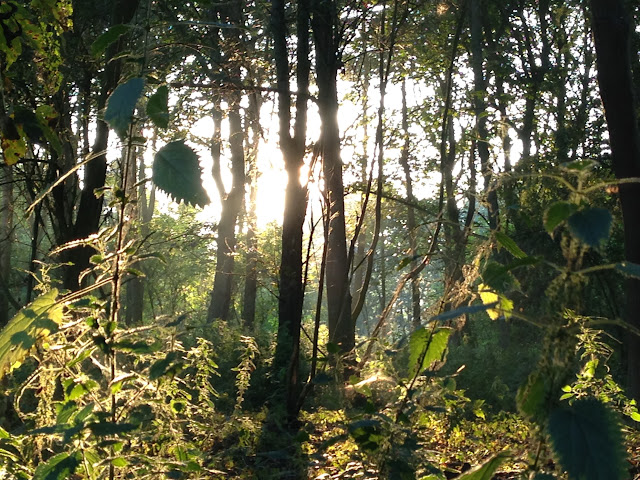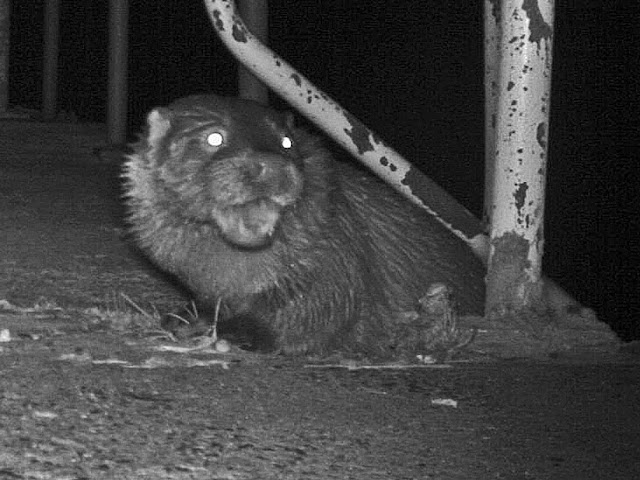Some of you may have seen brief snippets in the press regarding the new reception hide here at Tophill Low recently - needless to say this is progressing well but we want to be sure of dates and the like before we make final notification of the project. That hasn't stopped the woodland works from progressing well into which it wild sit. Our objective this winter has centred solely on the area behind the car park and North Lagoon to create a much more enjoyable walk for enthusiasts visiting the new facility. Currently its fair to say the walk can be a little bleak for the first few hundred yards in each direction but we hope by next year it will be transformed.
A lot of work has centred on the removal of likely thousands of sycamore saplings from beneath the mature original planting. This species seeds prolifically and has smothered all light to the woodland floor eliminating ground flora and creating a 'bean pole' wood with long leggy stems devoid of nesting habitat for birdlife. Initial works last year gave us a glimpse of what we could attain just by the addition of some light - the foxglove display was spectacular last season and promises to be so this too:
Before Christmas our practical volunteer team took a tour of Chambers Farm Wood in Lincs courtesy of the Forestry Commission who did a great job showing us their well managed coppice woodland which holds dormice to help us look at potential and management techniques. As such we've carefully removed some mature trees to create space for our better trees to spread and become specimens. Many people do not realise the quite impressive oak trees near the D reservoir and freshly thinned these have room to grow again and become real veterans, along with many original sycamores - as in this era of tree diseases it is wise to hedge one's bets.
The tree management has extended to many of the old crack willow pollards in the wet areas. These have been cut many moons ago - and ideally are re-cut every 5-15 years to maximise habitat potential for feeding and breeding warblers giving these splendid characterful trees - a testament to generations of wardens and volunteers:
Alas these became something of a marathon effort:
As always we've left all the standing dead wood in - this careful management helps to deliver willow tit breeding sites. A lot of work has created an excellent new wetland habitat with a very promising ditch - now that several tons of rotten wood have been dragged out from its depths:
It's hoped that all of this will be on offer to visitors from the new path network next year.
Further down stream a lot of work is being finished off on North Lagoon at the moment. After our improvement works last year we had some great views of waders like wood sandpiper at close range for the first time in 10 years. However the management of water levels was very challenging due to multiple blockages and leaks. The volunteer team have been busy clearing willows from the left of the hide and laying beech and alder to give great views whilst providing cover from disturbance. Meanwhile between the lagoons this breach in the 1950's bund made water control impossible with water flowing into North Lagoon that should have been going south:
We've been using plastic piling as a long term solution to the porous bund (thanks to the Yorkshire Wildlife Trust for the loan of their piling capper). Very wet and mucky work saw the removal of a willow that had punctured the bund initially (last year's stop-gap offcut plywood pile gesture in corner);
With the unavoidably besodden volunteer;
Ken over piles his piles:
Slash and not so much burn: Ideally we'd have burnt off a lot of the bramble choked reeds to regrow again but the damp was not conducive unfortunately. Work is progressing well and we hope to put a quote in for Trump's wall next year.
However its not all devastation. We're likely planting as many trees as we have felled but of much more sympathetic species. We have good links with the Woodland Trust at Yorkshire Water and they are keen to influence and support our thousands of acres of woodland. As such they've provided us with 1500 new wet woodland and understorey species to improve the site. Around 1/3rd are hazel, and the rest feature alder, alder buckthorn, guelder rose, downy birch, sessile oak amongst an array of others. Last Friday was grim - but perfect weather to heel in 1500 trees:
In the background you'll also see the new propagation unit - we're also growing on hundreds of woodland plants to enhance the limited ground flora - creating a spectacular entrance to the reserve for future visitors.
Already spectacular is another Yorkshire Water site if you're not familiar with it. Brayton Barff is a Yorkshire Water owned woodland close to Selby. Our main contact Derek Cooper has published this illustrated online account of a year of wildlife on the site. The flycatchers are a standout feature - well worth a read here.
So that's what we've been up to - but what about the wildlife? Generally lots of this behaviour...
Mating sparrowhawks on North Marsh this morning courtesy of Roy Vincent and Maurice Dowson as per below:
This is perhaps the culmination of much activity up there of late as also captured by Bruce Pillinger:
Kestrels too seem to be really active on the reserve too at present - Maurice Dowson capturing a launch:
And a less than glamorous hunt on the D reservoir grass:
And reassuringly in spite of the loss of the buzzard in the last post we had a pair mating on the access road on Saturday and a number of birds kettling around site. Marsh Harrier too continues to be active.
The southern marshes at some periods this winter were very quiet, but this is completely reversed now. We reckon this could be the most hectic year ever and will be a massive spectacle. Last year we worked to improve the habitat but it came late at the expense of breeding wildfowl which went elsewhere. This year the new habitat dubbed 'Palm Island' is ready and waiting - pictures courtesy of George Stoyle / Yorkshire Wildlife Trust:
The result is currently 4 pairs of shelduck with a further 1 on SMW and Watton respectively:
Likewise on Saturday's reserve walk we had 14 drake shoveler present on the marsh too, not to mention scrapping coot, gadwall and mallard posturing and reports of displaying great crested grebe. This is before the 14 pairs of terns and dozens of gulls return. With avocet that had a look last year and lesser black backed's both a likely returnee it will be frenetic. Both here and on North Marsh swans are primed and ready to go - this pair looking like building a nest in front of the hide - Roy Vincent:
Maurice Dowson:
Even the roe deer are frisky - rutting being spring time for them - Darren Smith:
And Bruce Pillinger:
Other sightings through the month include:
Scaup - the drake on D res regularly from the 1st Feb onwards
Mediterranean gull - again near daily
Iceland gull - a nice seasonal treat from a mild winter by Martin on the 6th & 7th
Bittern - finally pushed out by the ice on the 7th Feb
Goosander on the 7th, 9th, 21st, 23rd, 29th, Feb
Yellow legged gull on the 8th, 11th Feb
Kittiwake on the 8th Feb, 2nd March.
Little Gull on the 8th (perhaps the finest gull diversity day ever!)
Eurasian white fronted goose on the 9th - 13th on Watton
Along with Barnacle
And pink feet on the 10th, 13th, Feb, 2 Mar
9 snipe disturbed from Hempholme Meadow on the 11th
Whooper swans on the 18th
Greenfinch (!!) on the feeders on the 18th
Red crested pochard 18th
55 Golden plover on the 19th
Brambling on the 20th
Dunlin 1st March (heading north)
And to round off a winter that passed us by; Short eared owl on SME on the 6th March.
Grey partridge again visible on the access road
Our next post will likely feature sand martin, osprey, chiffchaff and little ringed plover - who's going to bag the first... Marsh tit, willow tit, cetti's warbler are fixtures on site.
But not all is rosy and sinister forces lay beneath.
At the end of last year we showed you some of our trail camera footage of an otter possibly taking a black headed gull. Since then it seems in these images supplied by Hull Uni student Zoe Latham who's undertaking a degree project on the population here it seems there is ready activity:

Often it appears to be a big dog - a useful size comparison here:
But the main interest has been what it has been hauling out; Coot had been observed earlier - but unfortunately this struggling tufted duck was also on the menu:
But seemingly dispatched earlier was this substantial large sub adult gull - possibly great black back:Most are seemingly hauled out and into the marsh next door. Wildlife in action - ultimately its a native predator feeding on native birds. Further up the reserve two cubs were picked up at North Marsh last week - but equally a young male otter was killed on the road at Watton over the weekend - so the population maintains itself.
And a photo-bombing redshank:
Some great shots were seen last week of the otter doing the back stroke up North Marsh - so as ever to see one in 'real life' its just a waiting game. Check out James Sharp's photography site for pictures of this an other too here.
For even bigger predators we have a treat in store courtesy of Josh Harrison - local and very talented wildlife photographer. Between March 18th and the 1st of April daily (excluding Wednesdays) we will have an exhibition of some of his best Arctic photos on show entitled:

On the evening of the 18th at 7:30pm Josh will be launching the exhibition with an illustrated talk - free but numbers are limited. If you would like to attend please contact Josh on
joshharrisonphotography@outlook.com to register your interest before the 15th.
Visiting this could be the perfect time too for membership renewals. Subs for the April 2016-17 membership are due later this month - prices as per last year. The new permits will be in any day now and we'll post on the blog with the winning design revealed once they are ready for purchase.
Finally the much anticipated events programme is up on the events page above now too, .











































